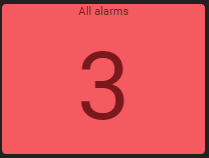Alarm Severity¶
Overview¶
List of configuration files¶
Filename |
Short description |
Format |
Link to documentation |
|---|---|---|---|
dashboard.view#AlarmSeverityWidget |
Defines the AlarmSeverityWidget widget global settings |
json |
Features¶
Alarm severity widget allows displaying alarms count and severity associated with filters.
Example of basic I/O widget:

It consists of two elements:
Count: The number of alarms matching the filter (with the foreground and background color matching highest severity)
Label: A label describing the alarm severity (optional)
The following parameters can be used for the alarm severity:
Setting |
Usage |
Type |
Default value |
count |
The value representing the alarm count |
value ID |
|
severity |
The value representing the maximum alarm severity |
value ID |
|
label |
The label to show for the alarm severity or disable |
string or boolean |
|
labelPosition |
Whether to show the label at the top or bottom |
“top” or “bottom” |
“top” |
labelPercent |
The label height in percent |
0-100 |
20 |
Example of alarm severities:
{
"alarmSeverityWidgetSettings": {
"count": "root.alarms.filters.all.count",
"severity": "root.alarms.filters.all.max",
"labelPercent": 10,
"label": "All alarms",
"labelPosition": "top"
}
}
Widget context¶
It is possible to access dynamic evaluation using onClick. In addition to shared context, available content is:
osp.widgets(id): to access any widget available in current dashboard using widgetid. This will allow access to widget exposed features.osp.navigate(path)to navigate to any dashboard (path format:root.dashboard.path) (previouslyosp.navigateTo, still supported)osp.evaluate(code): to allow menucodeinteraction evaluation (see dynamic evaluation)